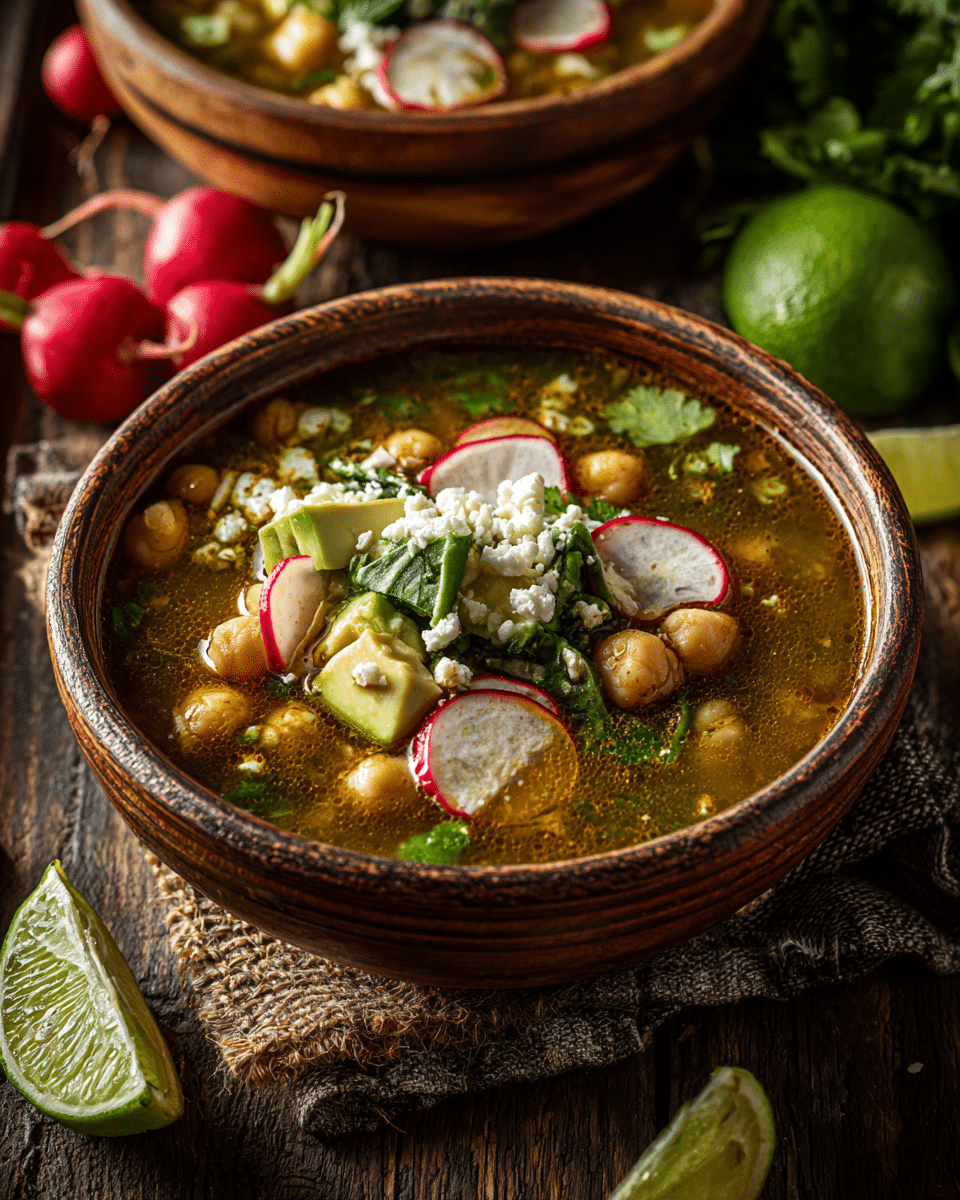Vegan Pozole Verde or Rojo is a plant-based twist on one of Mexico’s most beloved traditional dishes, often enjoyed during Mexican Independence Day celebrations and family gatherings. This comforting soup is made with hominy and an array of rich vegetables, simmered in either a vibrant green tomatillo-based sauce (verde) or a deep red chili-based sauce (rojo).
FULL RECIPE
Ingredients
- 2 tablespoons olive oil
- 1 large white onion, chopped
- 4 cloves garlic, minced
- 2 cans (15 oz each) white hominy, drained and rinsed
- 6 cups vegetable broth
- 2 medium zucchinis, diced
- 2 cups mushrooms, sliced
- 1 teaspoon dried oregano
- 1 teaspoon ground cumin
- Salt and pepper, to taste
1.For Verde Sauce:
- 8 tomatillos, husked and rinsed
- 2 poblano peppers, seeded and chopped
- 2 jalapeños, seeded (optional for heat)
- 1 cup fresh cilantro leaves
- Juice of 1 lime
2.For Rojo Sauce:
- 4 dried guajillo chilies, stemmed and seeded
- 2 dried ancho chilies, stemmed and seeded
- 1 dried pasilla chili, stemmed and seeded
- 2 cups hot water (for soaking chilies)
- 1 medium tomato, chopped
3.Optional Garnishes:
- Shredded lettuce or cabbage
- Sliced radishes
- Diced avocado
- Chopped cilantro
- Lime wedges
- Tortilla chips or tostadas
Directions
- Prepare the Sauce: For verde, boil tomatillos, poblano peppers, and jalapeños for 5 minutes until softened, then blend with cilantro and lime juice until smooth. For rojo, soak dried chilies in hot water for 15 minutes, then blend with tomato until smooth.
- Sauté the Aromatics: In a large pot, heat olive oil over medium heat. Add onion and garlic, cooking until translucent.
- Add Vegetables: Stir in zucchini and mushrooms, cooking for 5 minutes until softened.
- Combine with Sauce: Pour the prepared verde or rojo sauce into the pot, stirring to coat the vegetables. Cook for 2 minutes to develop flavor.
- Add Hominy & Broth: Stir in the hominy, oregano, cumin, and vegetable broth. Bring to a boil, then reduce heat to a simmer.
- Simmer: Cover and cook for 25–30 minutes, allowing flavors to meld. Season with salt and pepper to taste.
- Serve: Ladle into bowls and top with garnishes like lettuce, radishes, avocado, cilantro, and lime juice. Serve with tortilla chips or tostadas.
Nutrition Facts
- Calories: 210
- Protein: 6g
- Carbohydrates: 38g
- Dietary Fiber: 8g
- Sugars: 6g
- Fat: 6g
- Saturated Fat: 1g
- Sodium: 720mg
- Potassium: 590mg
- Vitamin A: 15% DV
- Vitamin C: 40% DV
- Calcium: 8% DV
- Iron: 12% DV
Cultural Significance of Vegan Pozole
Pozole has deep cultural roots in Mexico, historically prepared as a celebratory dish for special occasions such as Independence Day, Christmas, and family gatherings. Traditionally made with pork or chicken, this vegan version preserves the ceremonial essence while aligning with plant-based diets. In many Mexican households, pozole is more than just food—it is a symbol of unity, hospitality, and pride. The act of gathering around a steaming pot of pozole brings people together, fostering connection and honoring traditions passed down for generations. The vegan adaptation demonstrates how cultural heritage can be respected while embracing modern dietary preferences.
Nutritional Benefits
Vegan pozole is nutrient-dense, offering a wide range of vitamins, minerals, and antioxidants without excess saturated fat or cholesterol. Hominy provides a hearty source of carbohydrates and fiber, supporting digestive health and sustained energy. Vegetables like zucchini, mushrooms, and tomatillos contribute essential micronutrients such as vitamin C, potassium, and folate. The addition of herbs and spices like oregano and cumin enhances flavor while supplying anti-inflammatory compounds. This combination makes vegan pozole a wholesome choice for those seeking both comfort and nourishment in one bowl.
Flavor Profiles: Verde vs. Rojo
The verde and rojo variations of pozole each offer distinct taste experiences. Verde, made with tomatillos, poblanos, and fresh herbs, delivers a tangy, slightly tart flavor with bright, herbal notes. It’s often considered lighter and more refreshing, making it perfect for warmer climates or those who enjoy citrusy undertones. Rojo, on the other hand, is made with dried red chilies like guajillo and ancho, providing a deep, smoky, and earthy taste with a subtle heat. Choosing between verde and rojo often comes down to personal preference, though both maintain the hearty comfort pozole is known for.
Garnish and Topping Traditions
One of the most beloved aspects of pozole is the array of garnishes served alongside it. Common toppings include shredded lettuce or cabbage, thinly sliced radishes, diced avocado, chopped cilantro, and lime wedges. These additions not only enhance the visual appeal of the dish but also add layers of texture and freshness. Crunchy vegetables contrast beautifully with the soft hominy and tender vegetables in the soup, while fresh lime juice brightens the overall flavor. Offering a variety of garnishes allows each person to customize their bowl to their liking, making every serving unique.
Serving Suggestions
Vegan pozole is traditionally served in deep bowls with a generous amount of broth and toppings piled high. It pairs wonderfully with tostadas or tortilla chips, which can be used to scoop up both broth and garnishes. For a more filling meal, serve it with Mexican rice or refried beans on the side. During festive occasions, pozole is often enjoyed with aguas frescas or atole to balance the savory flavors. Serving pozole family-style, with toppings in separate bowls, creates an interactive dining experience where guests can build their perfect serving.
Pairing with Beverages
The rich, complex flavors of vegan pozole pair beautifully with a variety of drinks. For a traditional option, aguas frescas made with hibiscus, tamarind, or horchata complement the dish with their natural sweetness and refreshing qualities. Beer lovers might enjoy a crisp Mexican lager or a light pale ale to cut through the richness of the broth. Those seeking non-alcoholic warmth might opt for atole, a thick corn-based drink, or café de olla, a spiced Mexican coffee. Each pairing enhances the meal, making the pozole experience even more satisfying.
Regional Variations in Mexico
While pozole is a national favorite, its preparation varies by region. In Guerrero, pozole verde is more common, with its vibrant green hue and herbaceous flavor. Jalisco is famous for its pozole rojo, often featuring a more intense chili flavor. In some coastal regions, seafood-based versions are prepared, though for vegan adaptations, mushrooms or jackfruit can mimic the texture of meat or seafood. These regional differences reflect the diversity of Mexican cuisine, where local ingredients and cultural influences shape the final dish.
Storage and Reheating Tips
Vegan pozole stores exceptionally well, making it a great option for meal prep. It can be refrigerated for up to 4 days in an airtight container, allowing the flavors to deepen over time. For longer storage, freeze in portions for up to 3 months. When reheating, warm over medium heat on the stovetop, adding a splash of vegetable broth if the consistency has thickened. Garnishes should always be stored separately to maintain freshness and texture. This make-ahead quality ensures that a comforting bowl of pozole is always within reach.
Health-Conscious Modifications
For those seeking a lighter version of vegan pozole, several modifications can be made. Reducing the amount of oil during the sautéing process lowers the fat content without compromising flavor. Adding more leafy greens like spinach or kale boosts the nutrient profile and adds visual appeal. To lower sodium, opt for low-sodium vegetable broth and season gradually, adjusting to taste. For added protein, incorporate legumes such as chickpeas or black beans. These adjustments allow the dish to fit seamlessly into various dietary needs while maintaining its comforting essence.
Conclusion
Vegan Pozole Verde or Rojo is more than just a meal it’s a celebration of heritage, flavor, and community. By adapting a cherished Mexican tradition into a plant-based version, it opens the door for more people to experience its warmth and cultural significance. Whether enjoyed at a festive gathering, a family dinner, or as a comforting weeknight meal, vegan pozole delivers nourishment for both body and spirit.






